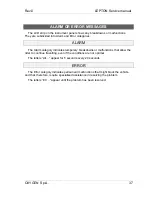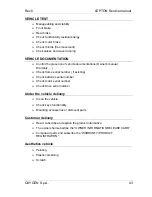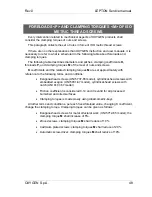
Rev.0 LEPTON
Service
manual
OXYGEN S.p.A.
35
The charge of the battery is a very important aspect.
The quality of the current supplied by the battery charger and the kind of charge are
very important for a good performance and for the time of life of the batteries.
Currents and/or too much high voltages, excessive endurances or insufficient
charges damages the battery, and surely they influence the next performance. At
present, you can find on the market “hermetic batteries”, more correctedly said “at
valve regulator gas recombination”; they fit very well for application on electric vehicles
for lack of maintenance, which is required instead by Pb traditional batteries and by
Nichel-Cadmio batteries.
Gas recombination batteries offer a high compatibility , have a very reduced gas
emission (until 10 times less than the traditional free electrolyte batteries) besides, in
case of breaking of their holder do not release corrosive liquids as it happens instead
with the other batteries.
Unfortunately this kind of batteries requires recharging curve according to the
specifications provided by the batteries producers. If the curve are not correct the
batteries might be damaged for an excess of a defect of recharge. So it is important to
recharge the LEPTON batteries with the battery charger provided or expressly
approved by OXYGEN.
How to check the batteries.
Operations of control must be made by experts who know the vehicle well. The
batteries, even if not connected to the vehicle, are “active” objects anyway and a short-
circuit can create dangerous situations.
With the “hermetic” batteries it is not possible to control the density of the electrolyte
just because of how they are produced, which is the traditional method of check of the
charge state and health state of free electrolyte batteries. In this case the only
necessary control that can be made is the check of the tension of every single battery
composing the battery pack.
Make this control at least half an hour after the end of charging, using a voltmeter to
read the tensions at the terminals, checking either the absolute value and its
homogeneity inside the group. To be considered charged, lead acid and Nichel-Zinc
batteries must have at the clips a tension not lower than 12.70 Volt (batteries with a
nominal tension of 12 Volt); lower values indicate clearly an insufficient charge.
Tensions higher than 13.40 Volt can indicate an overcharged battery; but before
giving a definitive judgement, in this case it is necessary to repeat the measurement at
least three hours after the end of charging, and it is necessary however to check the
functionality of the battery charger.
The difference of the tensions between the modules of the battery must be
contained within 0.2 Volt, higher values indicate an unbalanced battery pack. Warning:
different temperatures of battery might influence the evaluation of dishomogeneity.
The batteries need maintenance.
Even if the batteries are defined “without maintenance” it is necessary to carry out
some operations of control rather than of maintenance.
Check regularly the tightening of screws and clips, always using insulated tools, as
the loosening between two components made of different metals is usual, having the
















































